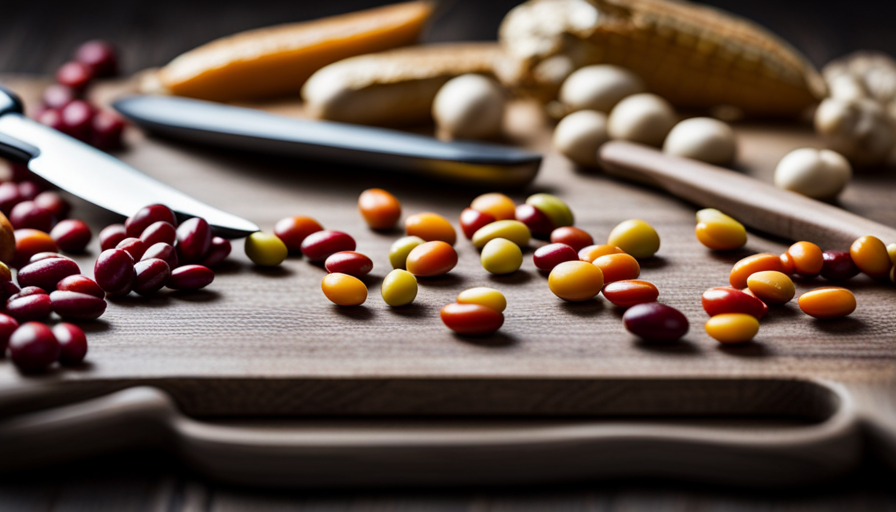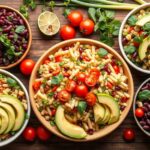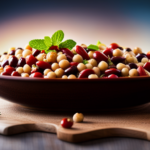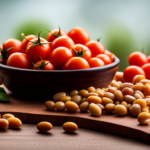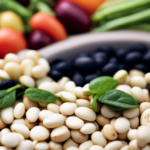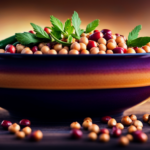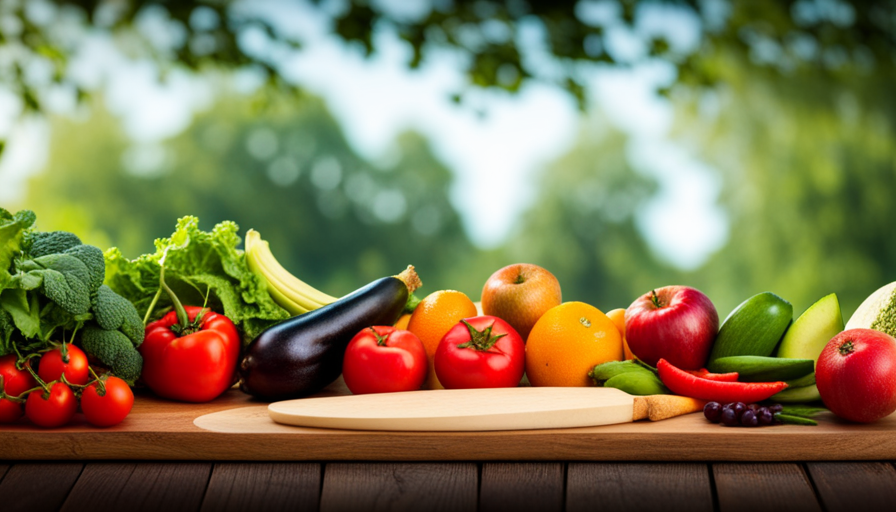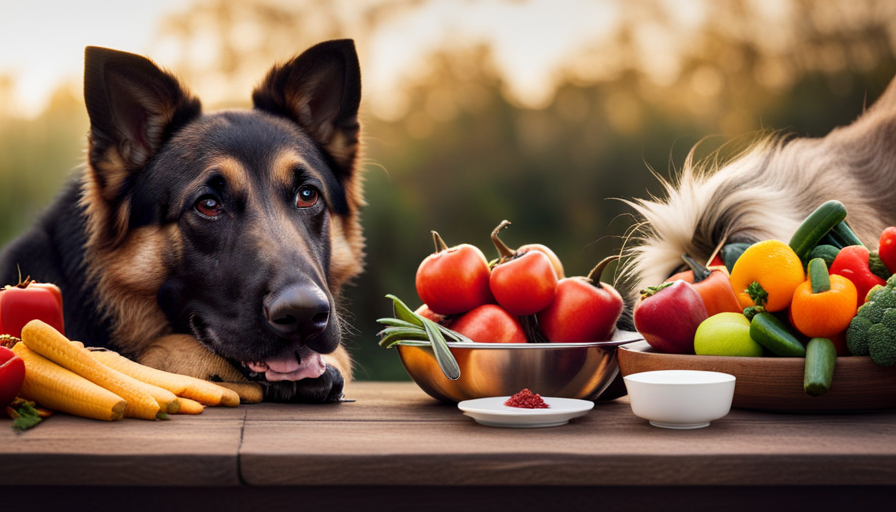The popular saying, ‘You are what you eat,’ holds true in the world of raw food diets. If you choose to adopt a raw food lifestyle, beans should become your go-to ingredient. Packed with essential nutrients, beans offer a multitude of options for preparing delicious meals. From sprouting to fermenting, there are various ways to cook beans that enhance their digestibility and maximize their nutritional value.
In this article, we will guide you through the art of preparing beans for a raw food diet. We will show you how soaking, sprouting, blanching, fermenting, dehydrating, and marinating can transform these humble legumes into delightful and nutritious dishes. Whether you’re craving a crunchy snack, a flavorful side, or a hearty soup, we’ve got you covered.
So grab your apron and let’s dive into the world of raw beans!
Key Takeaways
- Soaking beans before consuming them improves digestion and enhances their nutritional value.
- Sprouting beans increases nutrient availability and makes them easier to digest.
- Fermenting beans increases their nutritional value and adds probiotics to promote a healthy gut microbiome.
- Dehydrating beans removes moisture and extends their shelf life.
Soaking Beans for Optimal Digestion
Before you dive into the world of raw food, it’s essential to know that soaking beans is a game-changer for optimal digestion. Soaking beans not only makes them easier to digest but also enhances their nutritional value.
The process of soaking beans involves submerging them in water for a specific period of time, allowing them to absorb moisture and break down indigestible compounds.
The soaking time for beans varies depending on the type of bean. Generally, larger beans like kidney beans or chickpeas require a longer soaking time of around 8-12 hours, while smaller beans like lentils or mung beans only need 4-6 hours. It is important to follow the recommended soaking time to ensure that the beans are properly softened and ready for consumption.
Proper soaking techniques also play a crucial role in optimizing digestion. Firstly, it’s important to rinse the beans thoroughly before soaking to remove any dirt or debris. Then, place the beans in a large bowl and cover them with enough water, allowing room for expansion. Adding a pinch of salt or a tablespoon of lemon juice to the soaking water can help further break down the beans’ complex sugars and reduce gas production.
Soaking beans is a simple yet effective step to enhance the digestibility and nutritional value of raw food. By following the recommended soaking time and proper techniques, you can ensure that your beans are ready to be incorporated into a healthy and nourishing raw food diet.
Sprouting Beans for Enhanced Nutrient Availability
To maximize the nutrient content of your meal, why not try sprouting your beans? Sprouting beans is a simple and effective way to enhance the availability of nutrients in your food.
Sprouting techniques involve soaking the beans in water and allowing them to germinate. This process activates enzymes and increases the nutrient content of the beans.
One of the benefits of sprouted beans is increased nutrient availability. Sprouting breaks down complex carbohydrates and proteins into simpler forms that are easier for your body to digest. This increases the bioavailability of nutrients, allowing your body to absorb and utilize them more efficiently.
Sprouted beans are also a great source of vitamins, minerals, and antioxidants. The germination process enhances the levels of these nutrients, making sprouted beans a nutrient-dense addition to your raw food diet.
In addition to improved nutrient availability, sprouted beans also offer other health benefits. They are easier to digest compared to unsprouted beans, which can be tough on the digestive system. Sprouting also reduces the presence of antinutrients, such as phytic acid, which can interfere with nutrient absorption.
By sprouting your beans, you can enjoy a delicious and nutritious addition to your raw food diet. So why not give it a try?
Blanching Beans for Crunchy Texture
If you want to add a satisfying crunch to your meals, try blanching your beans. Blanching is a cooking technique that involves briefly immersing food in boiling water, followed by quickly cooling it down in ice water. This process helps to enhance the texture of the beans, making them crispy and delightful to bite into.
When blanching beans, it’s important to consider the correct blanching time and temperature. For most beans, a blanching time of 2-3 minutes is sufficient to achieve the desired crunchiness. However, this can vary depending on the size and type of beans you’re using. It’s best to start with a shorter blanching time and then adjust it accordingly to achieve the desired texture.
In terms of temperature, the water used for blanching should be boiling, around 212°F (100°C). This high temperature helps to quickly cook the beans, while still preserving their crunch. After blanching, the beans should be immediately transferred to a bowl of ice water to cool down and stop the cooking process. This step is crucial in maintaining the desired texture and preventing the beans from becoming overly soft.
By following proper blanching techniques and considering the blanching time and temperature, you can easily achieve a crunchy texture for your beans. So go ahead and give blanching a try to elevate the enjoyment of your raw food diet.
Fermenting Beans for Probiotic Benefits
Fermenting beans, like a bubbling cauldron of health, can unlock their probiotic benefits. When beans are fermented, beneficial bacteria break down the complex carbohydrates and proteins in the beans, making them easier to digest and increasing their nutritional value. Fermented beans are also packed with probiotics, which promote a healthy gut microbiome and boost immunity.
To make your own fermented bean recipes, you can start by soaking the beans overnight to soften them. Then, rinse them thoroughly and add them to a clean glass jar. Next, prepare a brine by dissolving salt in water and pour it over the beans, making sure they are fully submerged. You can also add spices or herbs for added flavor.
Cover the jar with a breathable cloth or a fermentation lid, and let the beans sit at room temperature for about 3 to 5 days. During this time, the beneficial bacteria will consume the sugars in the beans, producing lactic acid and creating that tangy, fermented flavor.
Once the beans have reached your desired level of fermentation, transfer them to the refrigerator to slow down the fermentation process. Fermented beans can be used in various recipes like salads, soups, or as a side dish. They add a unique flavor and texture while providing numerous health benefits.
| Fermented Bean Recipes | Health Benefits of Fermented Beans |
|---|---|
| Fermented Black Beans | Rich in antioxidants and beneficial enzymes |
| Fermented Soybeans | High in protein and beneficial bacteria |
| Fermented Chickpeas | Improved digestion and nutrient absorption |
| Fermented Kidney Beans | Enhanced mineral availability |
| Fermented Lentils | Increased vitamin content |
Incorporating fermented beans into your raw food diet can be a delicious way to boost your health and add variety to your meals. So go ahead, experiment with different bean varieties and flavors, and enjoy the benefits of fermented beans!
Dehydrating Beans for Snacks and Sprinkles
Dehydrating beans transforms them into crunchy and versatile snacks or flavorful sprinkles that’ll elevate your meals.
Dehydrating beans isn’t just a great way to extend their shelf life for long-term storage, it also enhances their nutritional value. When you dehydrate beans, you remove the moisture content, which helps prevent spoilage and the growth of bacteria or mold. This makes dehydrated beans an ideal pantry staple that you can rely on for a quick and nutritious snack or to add a burst of flavor to your dishes.
Using dehydrated beans in trail mixes is a fantastic way to incorporate them into your snack routine. You can mix dehydrated beans with nuts, dried fruits, and other crunchy ingredients to create a satisfying and energy-boosting trail mix. Dehydrated beans provide a good source of protein, fiber, and essential nutrients, making them a healthier alternative to traditional trail mix options.
In addition to trail mixes, dehydrated beans can also be used as sprinkles to enhance the flavor and texture of your meals. You can sprinkle them on top of salads, soups, or even roasted vegetables for an extra crunch. Their concentrated flavor adds depth to your dishes, making them more enjoyable and satisfying.
So, whether you’re looking for a convenient and nutritious snack or an easy way to elevate your meals, dehydrating beans is a simple and effective method that allows you to enjoy their benefits for a long time.
Grinding Beans into Flour for Baking
To make your baking adventures even more exciting, why not try grinding beans into flour? Not only does this add a unique twist to your recipes, but it also provides a nutritious alternative to traditional flours. There are various grinding techniques you can use to achieve the desired consistency.
One popular method is using a high-powered blender or food processor. Simply add the beans and blend until they turn into a fine powder. Another option is using a grain mill, which allows for more control over the texture of the flour. Whichever method you choose, make sure to thoroughly clean and dry the beans before grinding to prevent any moisture from affecting the final product.
Grinding beans into flour opens up a world of alternative flour options. Beans like chickpeas, lentils, and black beans can all be transformed into flour and used in a variety of recipes. These alternative flours not only add a unique flavor to your baked goods but also increase their nutritional value. They are naturally gluten-free, high in protein, and packed with vitamins and minerals.
To help you visualize the benefits of grinding beans into flour, here’s a comparison table:
| Traditional Flour | Bean Flour |
|---|---|
| High in gluten | Gluten-free |
| Low in protein | High in protein |
| Few nutrients | Packed with vitamins and minerals |
So go ahead and experiment with grinding beans into flour for your next baking project. Your taste buds and body will thank you!
Making Bean Pastes and Spreads
If you’re looking to add a burst of flavor and creaminess to your dishes, why not try your hand at making delicious bean pastes and spreads? Beans are not only a great source of protein and fiber, but they also provide a creamy texture that can elevate your dishes to a whole new level.
Here are four ways you can use beans to create tasty and nutritious dips and spreads:
-
Hummus: Made from chickpeas, hummus is a popular Middle Eastern dip that’s both creamy and tangy. You can easily make it at home by blending cooked chickpeas with tahini, lemon juice, garlic, and olive oil.
-
Black bean dip: Black beans are packed with protein and fiber, making them a perfect base for a delicious dip. Blend cooked black beans with lime juice, cumin, garlic, and a touch of salt for a flavorful and nutritious dip.
-
White bean spread: White beans have a mild flavor that pairs well with various herbs and spices. Blend cooked white beans with roasted garlic, rosemary, lemon zest, and a drizzle of olive oil for a creamy and aromatic spread.
-
Bean-based desserts: Believe it or not, beans can also be used in raw desserts! By blending cooked beans with dates, nuts, and cocoa powder, you can create a delicious and healthy brownie or truffle.
Making bean dips and using beans in raw desserts is a great way to incorporate these nutritious legumes into your diet while adding a burst of flavor to your dishes. Give it a try and explore the endless possibilities!
Marinating Beans for Flavorful Salads and Sides
Enhance the flavor of your salads and side dishes by marinating beans, allowing them to absorb a myriad of enticing flavors and transforming them into a delectable addition to your culinary repertoire. Marinating techniques can infuse beans with depth and complexity, taking them from plain and boring to flavorful and exciting.
To begin, choose your favorite bean variety and cook them until they’re tender but still firm. Once cooked, drain and rinse the beans under cold water to cool them down.
Next, prepare a marinade using a combination of ingredients such as olive oil, vinegar, lemon juice, garlic, herbs, and spices. The possibilities are endless, so feel free to experiment and find your preferred flavor profile.
Pour the marinade over the beans and gently toss them to ensure even coating. Let the beans sit in the marinade for at least 30 minutes, or longer if desired, to allow the flavors to penetrate the beans. The longer the marinating time, the more pronounced the flavors will be.
Marinated beans can be used in various ways, such as adding them to salads or serving them as a flavorful side dish. You can also use the marinade as a dressing for your bean salad, providing an extra burst of flavor.
Incorporating marinated beans into your raw food diet not only adds taste but also provides additional nutritional value. So, get creative with your marinating techniques and enjoy the delightful flavors that beans can bring to your salads and side dishes.
Incorporating Beans into Raw Soups and Stews
Indulge in the delightful experience of incorporating versatile legumes into your refreshing and nourishing soups and stews, allowing for a satisfying and flavorful addition to your culinary creations.
Beans are a wonderful ingredient to include in raw soups and stews as they provide a creamy texture and a rich flavor profile. Here are some ways to incorporate beans into your raw soups and stews:
-
Flavorful bean dips: Create a base for your soup or stew by blending beans with water or vegetable broth. This’ll add a creamy texture and enhance the overall flavor.
-
Bean-based raw dips and dressings: Use beans as a base for your raw dressings and dips. Blend them with herbs, spices, and other ingredients to create a flavorful and nutritious addition to your soups and stews.
-
Add cooked beans for texture: If you prefer a chunkier texture in your soup or stew, add cooked beans towards the end of the preparation process. This’ll provide a satisfying bite and add substance to your dish.
-
Experiment with different bean varieties: There are numerous types of beans available, each with its own unique flavor and texture. Try using different varieties such as black beans, chickpeas, or lentils to add variety to your soups and stews.
-
Garnish with bean sprouts: Bean sprouts not only add a crunchy texture to your soups and stews but also provide additional nutrients. Sprinkle them on top of your dish just before serving for a fresh and vibrant touch.
By incorporating beans into your raw soups and stews, you can elevate the flavors and nutritional value of your meals while enjoying their versatility.
Exploring Creative Raw Bean Recipes
Discover a world of culinary creativity with these delicious and innovative recipes that showcase the versatility and flavors of beans in their raw form.
Creative bean salad recipes are a great way to incorporate raw beans into your diet while enjoying a refreshing and nutritious meal. Try a colorful and vibrant black bean and corn salad, packed with fresh vegetables and a zesty lime dressing. Or, explore the flavors of the Mediterranean with a chickpea and tomato salad, topped with olives and feta cheese.
If you have a sweet tooth, you’ll be pleasantly surprised by the possibilities of raw bean desserts. From black bean brownies to chickpea cookie dough, these recipes offer a healthier twist on classic treats. The natural creaminess and mild flavor of beans make them a perfect base for creating rich and indulgent desserts without the need for processed ingredients.
Raw bean recipes not only provide a wide range of flavors and textures, but they also offer numerous health benefits. Beans are a great source of plant-based protein, fiber, and essential nutrients. They can help regulate blood sugar levels, improve digestion, and support heart health.
So, get creative in the kitchen and explore the delicious world of raw bean recipes for a flavorful and nutritious addition to your raw food diet.
Frequently Asked Questions
Are there any specific types of beans that are better for soaking, sprouting, blanching, fermenting, dehydrating, grinding, making pastes, marinating, incorporating into soups and stews, or exploring creative recipes?
When exploring creative bean recipes, there are various types of beans that work well for different preparations.
For soaking and sprouting, options like chickpeas and mung beans are popular choices.
Blanching is commonly done with green beans, while fermenting is often done with soybeans.
Kidney beans and black beans are great for dehydrating and grinding into flours.
Making pastes and marinating can be done with any type of beans.
Incorporating beans into soups and stews adds a nutritious boost and enhances flavor.
How long do you need to soak beans before they are ready to be used in a raw food diet?
Soaking beans before using them in a raw food diet can seem time-consuming, but the benefits make it worthwhile. The soaking time for beans varies depending on the type, but generally, they need to be soaked overnight or for at least 6-8 hours.
Soaking helps to remove anti-nutrients and improve digestibility. It also reduces cooking time and enhances the nutritional value of beans. So don’t be discouraged by the wait, as it’s an essential step for a healthier raw food diet.
Can you sprout beans without using any special equipment?
Yes, you can sprout beans at home without using any special equipment. Sprouting beans involves soaking them in water and allowing them to germinate. This process can be done easily using a glass jar, cheesecloth, and rubber band.
Sprouting beans has several benefits, including increased nutrient content, improved digestibility, and enhanced flavor. It also promotes the production of enzymes that aid in digestion.
Are there any safety concerns when fermenting beans for probiotic benefits?
When fermenting beans for probiotic benefits, there are some safety concerns to keep in mind. Improper fermentation can lead to the growth of harmful bacteria, causing foodborne illnesses. It’s important to ensure that the fermentation process is carried out in a controlled environment to prevent contamination.
However, when done correctly, fermenting beans can provide numerous benefits for gut health. Fermented foods are rich in beneficial bacteria, which can improve digestion and support a healthy gut microbiome.
What are some alternative uses for dehydrated beans besides snacks and sprinkles?
Get ready to explore the endless possibilities of dehydrated beans! These little powerhouses can do more than just satisfy your snack cravings. Think outside the box and discover their potential as an ingredient in creative recipes.
From hearty soups and stews to flavorful dips and spreads, dehydrated beans add a nutritious punch to any dish. So, get your culinary imagination flowing and unleash the magic of alternative uses for these versatile legumes.
What Are the Best Ways to Prepare Beans for a Raw Food Diet?
Incorporating beans into a raw food diet can be done by soaking and sprouting them to increase their nutrient content. You can also blend them into dips, spreads, or dressings for added fiber and protein. Another way is to marinate them in a flavorful sauce for a delicious raw snack or meal.
Conclusion
In conclusion, preparing beans for a raw food diet can be a fun and creative process. By soaking, sprouting, blanching, fermenting, dehydrating, and marinating beans, you can unlock their full potential and enjoy their numerous health benefits.
Just like a painter mixing colors on a canvas, you can experiment with different techniques and flavors to create delicious and nutritious meals. So don’t be afraid to dive into the world of raw bean recipes and let your culinary imagination soar like a bird in the sky.

